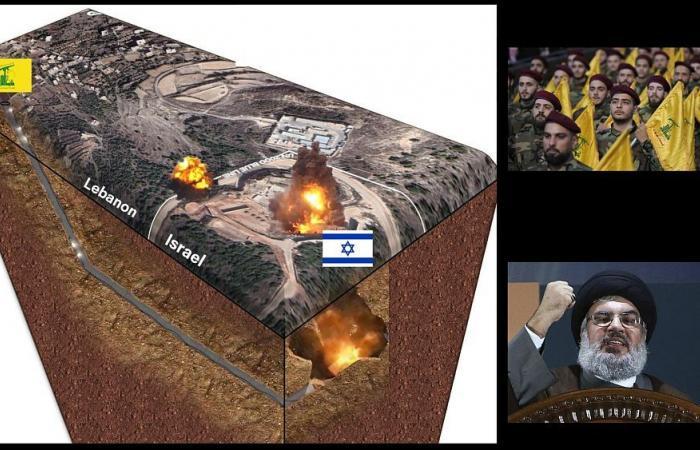
Hezbollah is building a network of explosive tunnels against Israel
The tactic has been known since ancient times, but it has never been built to such an extent and depth
Hassan Nasrallah, the leader of the Lebanese terrorist organization that emerged from the cloak of Iran, has been repeating for years that his organization is preparing “surprises” for the next clash with Israel.
Since its weapons and missile capabilities are known, they are nothing new. Nasrallah’s words are clearly about the construction of the tunnel system, and their goal is psychological and information manipulation warfare against the Israeli population.
The psychological part of the intimidation is that if the tunnel operations are even partially successful, Israelis’ confidence in the National Defense Force (IDF) will decrease.
The tactic is old and dangerous, but there are antidotes
The digging of tunnels to attack enemy positions by surprise was already known in antiquity, so the Romans also used it to capture several cities. The method was perfected in the American Civil War, when large quantities of explosives were installed in flights. During World War 1, both the Germans and the British dug hundreds of these tunnels under no man’s land, wreaking havoc on enemy defense lines.
The battle around the Messines Ridge in June 1917, when nineteen out of twenty-six tunnels exploded, is particularly memorable. Each trench contained twenty-one tons of explosives. The sound of the explosions could be heard as far as London.
As a result of the concerted attack, about 10,000 Germans were killed or buried alive under the mounds of earth, and thousands of shell-shocked soldiers were captured.
What is Hezbollah planning and where is it going with it?
The terrorist tunnels filled with explosives are therefore the threats that can be expected from Hezbollah during the future confrontation. Flights are of three types: offensive, infrastructural and strategic. Together, these form a network that is used for destruction, but also for the deployment of formations. Infrastructural trenches are also often used for drug smuggling.
The Israeli defense is already well aware of the tunnels used to bring in the units from the Gaza Strip, from where Hamas and Islamic Jihad militants try to break in, but with little success. These trenches are mostly rudimentary and can be measured with seismic instruments or infrared search satellites. The Israel Defense Forces usually blow them up.
Despite this, there were also successful actions from Gaza in the early 2000s. In September 2001, a tunnel exploded on the Gaza-Egypt border under the IDF position called “Old Termit”. Three soldiers were injured in the incident and the Israeli military was forced to evacuate the post. The attack was repeated in December 2003.
The military post called “Orhan” was destroyed in June 2004 by hundreds of kilograms of explosives hidden under it. One soldier was killed and five others were wounded. Five Israeli soldiers were killed in an incident in December.
The threat from the north, i.e. the tunnels packed with explosives, are much more dangerous. They are also more difficult to detect, because they lie much deeper than their counterparts in Gaza. Their use can cause significant destruction. Due to their underground location, explosive charges have more of an earthquake effect than aerial bombs or missiles, and can destroy a community, facility, or even a small town by collapsing from below.
Currently, the Middle East is the largest field of underground warfare
During the Syrian civil war, Al-Nusra Front and ISIS both built tunnels and used explosives to strike permanent military bases of the Syrian government and militias fighting alongside it.
One prominent case is the attack on the Syrian Air Force’s intelligence center in Aleppo. The terrorists set off a significant amount of explosives in a tunnel they dug in March 2015. . The building collapsed as a result of the explosion. In connection with this, the opposition militants launched an immediate ground attack in the area.
The northern area is quite unprotected
A number of Israeli military posts and communities along the Lebanese border are fairly easy targets. They are also more difficult to detect because they are locked and have no movement or electronic activity inside them, they just wait to be activated.
Often it is not even necessary to dig directly under the target, but it is enough to activate it in the area. In this case, the force of the explosion blows away the earth and rocks near the target, creating a kind of rock tsunami. For example, an explosion under the Ramim Ridge, which overlooks the city of Kiryat Shmona, could collapse parts of the mountain and send it crashing down onto homes and institutions.
Hezbollah is increasingly mentioning the Radwan unit, whose strategic task is to break through the northern border barrier and attack Gailea. Their tactics are constantly evolving after the IDF discovered Hezbollah’s main attack tunnels in 2018. According to the assumptions, new ditches have been built since then, but more widely, i.e. more difficult to detect.
Israeli Major General Yaakov Amidror claims that Israel understood the danger of the tunnels, but did not understand its true meaning, because psychological factors must also be taken into account. “There is a human barrier between intellectual and practical understanding. If I want to believe that everyone understands the practical significance of tunnels, the answer is no.”
Source » postsen





